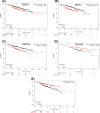Prognostic values of F-box members in breast cancer: an online database analysis and literature review
- PMID: 30341246
- PMCID: PMC6328874
- DOI: 10.1042/BSR20180949
Prognostic values of F-box members in breast cancer: an online database analysis and literature review
Abstract
Introduction: F-box proteins are the substrate-recognizing subunits of SKP1 (S-phase kinase-associated protein 1)-cullin1-F-box protein (SCF) E3 ligase complexes that play pivotal roles in multiple cellular processes, including cell proliferation, apoptosis, angiogenesis, invasion, and metastasis. Dysregulation of F-box proteins may lead to an unbalanced proteolysis of numerous protein substrates, contributing to progression of human malignancies. However, the prognostic values of F-box members, especially at mRNA levels, in breast cancer (BC) are elusive. Methods: An online database, which is constructed based on the gene expression data and survival information downloaded from GEO (http://www.ncbi.nlm.nih.gov/geo/), was used to investigate the prognostic values of 15 members of F-box mRNA expression in BC. Results: We found that higher mRNA expression levels of FBXO1, FBXO31, SKP2, and FBXO5 were significantly associated with worse prognosis for BC patients. While FBXO4 and β-TrCP1 were found to be correlated to better overall survival (OS). Conclusion: The associated results provide new insights into F-box members in the development and progression of BC. Further researches to explore the F-box protein-targetting reagents for treating BC are needed.
Keywords: F-box; breast cancer; literature review; prognostic value.
© 2019 The Author(s).
Conflict of interest statement
The authors declare that there are no competing interests associated with the manuscript.
Figures



Similar articles
-
Recent advances in SCF ubiquitin ligase complex: Clinical implications.Biochim Biophys Acta. 2016 Aug;1866(1):12-22. doi: 10.1016/j.bbcan.2016.05.001. Epub 2016 May 5. Biochim Biophys Acta. 2016. PMID: 27156687 Free PMC article. Review.
-
F-box protein FBXO41 suppresses breast cancer growth by inducing autophagic cell death through facilitating proteasomal degradation of oncogene SKP2.Int J Biochem Cell Biol. 2022 Jun;147:106228. doi: 10.1016/j.biocel.2022.106228. Epub 2022 May 19. Int J Biochem Cell Biol. 2022. PMID: 35598880
-
Regulation of neddylation and deneddylation of cullin1 in SCFSkp2 ubiquitin ligase by F-box protein and substrate.Proc Natl Acad Sci U S A. 2006 Aug 1;103(31):11515-20. doi: 10.1073/pnas.0603921103. Epub 2006 Jul 21. Proc Natl Acad Sci U S A. 2006. PMID: 16861300 Free PMC article.
-
Clinical and biological significance of S-phase kinase-associated protein 2 (Skp2) gene expression in gastric carcinoma: modulation of malignant phenotype by Skp2 overexpression, possibly via p27 proteolysis.Cancer Res. 2002 Jul 1;62(13):3819-25. Cancer Res. 2002. PMID: 12097295
-
Deregulation of F-box proteins and its consequence on cancer development, progression and metastasis.Semin Cancer Biol. 2016 Feb;36:33-51. doi: 10.1016/j.semcancer.2015.09.015. Epub 2015 Sep 30. Semin Cancer Biol. 2016. PMID: 26432751 Free PMC article. Review.
Cited by
-
Expression of Genomic Instability-Related Molecules: Cyclin F, RRM2 and SPDL1 and Their Prognostic Significance in Pancreatic Adenocarcinoma.Cancers (Basel). 2021 Feb 18;13(4):859. doi: 10.3390/cancers13040859. Cancers (Basel). 2021. PMID: 33670609 Free PMC article.
-
Risk Stratification for Breast Cancer Patient by Simultaneous Learning of Molecular Subtype and Survival Outcome Using Genetic Algorithm-Based Gene Set Selection.Cancers (Basel). 2022 Aug 25;14(17):4120. doi: 10.3390/cancers14174120. Cancers (Basel). 2022. PMID: 36077657 Free PMC article.
-
Diosgenin Exerts Antitumor Activity via Downregulation of Skp2 in Breast Cancer Cells.Biomed Res Int. 2020 Jun 16;2020:8072639. doi: 10.1155/2020/8072639. eCollection 2020. Biomed Res Int. 2020. PMID: 32626765 Free PMC article.
-
Skp2 modulates proliferation, senescence and tumorigenesis of glioma.Cancer Cell Int. 2020 Mar 6;20:71. doi: 10.1186/s12935-020-1144-z. eCollection 2020. Cancer Cell Int. 2020. PMID: 32165861 Free PMC article.
-
FBXW7 attenuates tumor drug resistance and enhances the efficacy of immunotherapy.Front Oncol. 2023 Mar 14;13:1147239. doi: 10.3389/fonc.2023.1147239. eCollection 2023. Front Oncol. 2023. PMID: 36998461 Free PMC article. Review.
References
Publication types
MeSH terms
Substances
LinkOut - more resources
Full Text Sources
Medical
Research Materials
Miscellaneous

